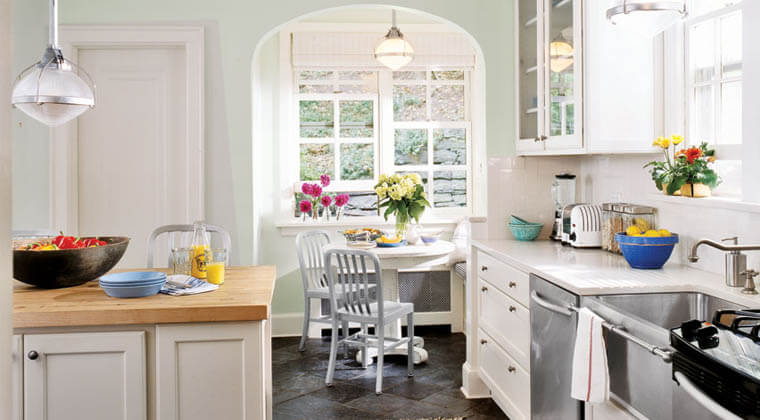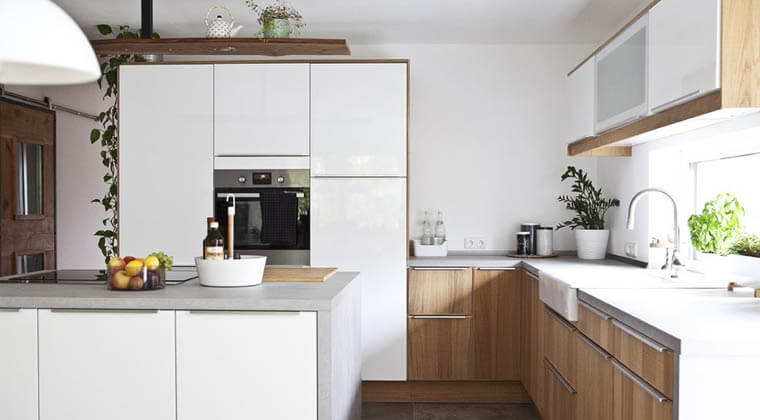When it comes to choosing the best lighting for a small kitchen, there are a few key factors to consider. First, it’s important to have a good mix of task, ambient, and accent lighting to create a well-lit and functional space.
Task lighting is essential for tasks such as chopping, cooking, and cleaning, and should be placed in areas where you need the most light, such as above the countertops and sink. Ambient lighting provides overall illumination and can be achieved with a combination of overhead lights, pendant lights, or under-cabinet lights. Accent lighting adds visual interest and can be used to highlight specific features or areas of the kitchen, such as a backsplash or artwork.
In terms of specific lighting options, some good options for a small kitchen include:
- Pendant lights: Pendant lights are a great option for small kitchens because they provide task lighting without taking up much space. You can choose from a variety of styles and sizes to suit your kitchen’s design.
- Under-cabinet lights: Under-cabinet lights provide task lighting for countertops and are a great space-saving option for small kitchens. They can be installed directly under the cabinets and provide focused illumination for tasks such as food prep and cooking.
- LED strip lights: LED strip lights are a versatile and energy-efficient option for small kitchens. They can be used for ambient, accent, or task lighting and are easy to install and customize.
Table of Contents
The Importance of Proper Lighting in a Small Kitchen

Proper lighting is crucial in any kitchen, but it’s especially important in a small kitchen where space is limited and every detail counts. The right lighting can help to make the space feel larger, brighter, and more inviting, and can also improve the functionality of the kitchen by providing the necessary light for tasks such as cooking and cleaning.
One of the most important things to consider when it comes to lighting a small kitchen is the role of natural light. If your kitchen has windows, make sure to take advantage of them by keeping them clean and unblocked. Natural light can help to make the space feel more open and airy, and can also provide the necessary light for tasks during the day.
In addition to natural light, task lighting is also important in a small kitchen. Task lighting is focused lighting that is specifically designed to provide the necessary light for specific activities, such as cooking or cleaning. In a small kitchen, it’s a good idea to use task lighting over the countertops and sink to provide the necessary light for food prep and cleanup.
Accent lighting is another key element of proper lighting in a small kitchen. This type of lighting is used to highlight certain features or areas of the space, and can add depth and interest to the overall design. In a small kitchen, accent lighting can be used to highlight the backsplash, decorative elements, or interesting architectural details.
In conclusion, proper lighting is essential in a small kitchen. By taking advantage of natural light, using task lighting for important tasks, and adding accent lighting for visual interest, you can create a beautiful and functional space that you’ll love spending time in.
The Benefits of Natural Light for a Small Kitchen

Natural light is one of the best things you can have in a small kitchen. Not only does it provide a beautiful and inviting atmosphere, but it can also have a number of practical benefits that can improve the functionality and comfort of the space.
One of the main benefits of natural light in a small kitchen is that it can make the space feel larger and more open. Natural light has a way of brightening and enlarging a space, which can be especially useful in a small kitchen where every square inch counts. By letting in as much natural light as possible, you can create the illusion of a larger kitchen and make the space feel more inviting and comfortable.
Another benefit of natural light in a small kitchen is that it can improve the quality of the light in the space. Natural light is typically softer and more diffuse than artificial light, which can make it easier on the eyes and reduce strain and fatigue. This is especially important in a kitchen where you may be spending long hours preparing food or cleaning up.
In addition to these benefits, natural light can also save you money on your energy bills. By relying on natural light during the day, you can reduce your reliance on artificial lighting and potentially save on your electricity costs.
In conclusion, natural light is a valuable asset in a small kitchen. It can make the space feel larger, improve the quality of the light, and save you money on your energy bills. By taking advantage of natural light, you can create a beautiful and functional space that you’ll love spending time in.
Types of Lighting
When it comes to choosing the best lighting for a small kitchen, it’s important to understand the different types of lighting and how they can be used to create a well-lit and functional space.
The three main types of lighting are task, ambient, and accent lighting.
- Task lighting is essential for tasks such as chopping, cooking, and cleaning, and should be placed in areas where you need the most light, such as above the countertops and sink. This type of lighting should be bright and focused to provide adequate illumination for specific tasks.
- Ambient lighting provides overall illumination and can be achieved with a combination of overhead lights, pendant lights, or under-cabinet lights. This type of lighting should be bright enough to evenly light the entire space and create a comfortable and inviting atmosphere.
- Accent lighting adds visual interest and can be used to highlight specific features or areas of the kitchen, such as a backsplash or artwork. This type of lighting can be achieved with spotlights, recessed lighting, or strip lights and should be used in moderation to avoid overwhelming the space.
Overall, a good mix of task, ambient, and accent lighting is essential for creating a well-lit and functional small kitchen.
Task lighting for small kitchen
Task lighting is essential for a small kitchen, as it provides focused illumination for specific tasks, such as chopping, cooking, and cleaning. Without adequate task lighting, it can be difficult to see what you’re doing and can lead to accidents or injuries.
When choosing task lighting for a small kitchen, it’s important to consider the placement and intensity of the light. Task lighting should be placed in areas where you need the most light, such as above the countertops and sink. It should also be bright enough to provide adequate illumination for the task at hand.
Some good options for task lighting in a small kitchen include pendant lights, under-cabinet lights, and LED strip lights. Pendant lights are a great option because they provide focused illumination without taking up much space. Under-cabinet lights are also a space-saving option and provide task lighting for the countertops. LED strip lights are versatile and can be used for ambient, accent, or task lighting.
Overall, task lighting is essential for a small kitchen and should be chosen carefully to provide adequate illumination for specific tasks.
Ambient lighting for small kitchen
Ambient lighting is important for a small kitchen, as it provides overall illumination and creates a comfortable and inviting atmosphere. Without adequate ambient lighting, a small kitchen can feel cramped and poorly lit.
When choosing ambient lighting for a small kitchen, it’s important to consider the placement and intensity of the light. Ambient lighting should be bright enough to evenly light the entire space and create a comfortable and inviting atmosphere.
Some good options for ambient lighting in a small kitchen include overhead lights, pendant lights, and under-cabinet lights. Overhead lights are a good option because they provide overall illumination and can be installed in a variety of styles and sizes to suit your kitchen’s design. Pendant lights are also a good option and can be used to add visual interest and focus light on specific areas of the kitchen. Under-cabinet lights are a space-saving option and provide task lighting for the countertops.
Overall, ambient lighting is essential for a small kitchen and should be chosen carefully to provide adequate illumination and create a comfortable and inviting atmosphere.
Accent lighting for small kitchen
Accent lighting can be a great way to add some extra flair to your small kitchen. This type of lighting is used to highlight certain features or areas of the space, and can add depth and interest to the overall design.
One of the best ways to use accent lighting in a small kitchen is to focus on the backsplash. By installing small, subtle lights along the backsplash, you can create a beautiful glow that will draw the eye and add warmth to the space. You can also use accent lighting to highlight any interesting architectural details or decorative elements in the kitchen, such as a unique countertop or a piece of artwork.
Another option for accent lighting in a small kitchen is to use under-cabinet lights. These lights can be installed underneath the upper cabinets, and provide a soft, diffuse light that can help to illuminate the countertop and make the space feel larger. You can also use them to highlight any special dishes or glassware that you want to display.
When choosing accent lighting for your small kitchen, it’s important to consider the overall design of the space. Look for lights that complement the color scheme and style of the room, and be sure to consider the amount of light that the fixtures will provide. Accent lighting should be used to enhance the space, not overpower it, so be sure to use it sparingly and with intention.
In conclusion, accent lighting can be a great way to add some extra character and interest to your small kitchen. By focusing on key features and using the right fixtures, you can create a beautiful and inviting space that you’ll love spending time in.
Tips for Choosing the Best Lighting for Your Small Kitchen
Choosing the best lighting for your small kitchen can be a challenge, but with the right approach, you can create a beautiful and functional space that you’ll love spending time in. Here are some tips to help you choose the best lighting for your small kitchen:
- Consider the size and layout of your kitchen: The size and layout of your kitchen will play a big role in determining the best lighting options for your space. In a small kitchen, it’s important to choose fixtures that won’t overwhelm the space and that will provide the necessary light without taking up too much room.
- Think about the activities that will take place in the space: The lighting in your kitchen should be tailored to the specific tasks and activities that will take place in the space. For example, if you do a lot of cooking, you’ll need task lighting over the countertops and sink to provide the necessary light for food prep.
- Choose fixtures that complement the design of the room: The lighting fixtures you choose should complement the overall design of your small kitchen. Look for fixtures that match the color scheme and style of the space, and that will add to the overall aesthetic of the room.
- Opt for energy-efficient lighting options: When choosing lighting for your small kitchen, it’s a good idea to opt for energy-efficient options. LED lights are a great choice because they use less energy and last longer than traditional incandescent bulbs.
In conclusion, choosing the right lighting for your small kitchen is important. By considering the size and layout of the space, thinking about the activities that will take place in the space, choosing fixtures that complement the design of the room, and opting for energy-efficient options, you can create a beautiful and functional space that you’ll love spending time in.
See also: Best Coffee Maker for Small Kitchen

Hi, I’m Jen from New Mexico. I have been working from home as a graphic designer for a long time. While working at home, I realized that I enjoy spending time in the kitchen. The kitchen is my biggest hobby. I set up this site to relay the products and experiences I’ve tried. I review many kitchen equipment and share them with you!
